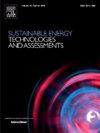Online condition monitoring and state of health estimation method for lithium-ion batteries based on time-ratio features
IF 7
2区 工程技术
Q1 ENERGY & FUELS
Sustainable Energy Technologies and Assessments
Pub Date : 2025-05-28
DOI:10.1016/j.seta.2025.104364
引用次数: 0
Abstract
Condition monitoring and state of health estimation are crucial for ensuring the secure operation of lithium-ion batteries. To address the difficulty in thoroughly capturing the changes in the state of the partial charging and discharging processes of the battery and the high demand for real-time performance of battery condition monitoring, a method for online condition monitoring and state of health estimation of lithium-ion batteries based on time-ratio features from the whole process is proposed. The health features are derived from the battery’s full charging and discharging curves, and the correlation methodology is used to analyse the relationship with the state of health. The proposed random forest-based online condition monitoring model and gated recurrent unit-based state of health estimation model are conducive to timely monitoring abnormal conditions and accurate estimation to ensure safe battery operation. Finally, the proposed method can realise accurate and real-time online condition monitoring with a classification accuracy of more than 0.93 and running time of less than 0.2 ms, and achieve better performance of state of health estimation under different ambient temperatures, with a root-mean-square error of less than 0.02 at room temperature and less than 0.01 at 43 °C.
基于时比特征的锂离子电池在线状态监测与健康状态估计方法
状态监测和健康状态评估是保证锂离子电池安全运行的关键。针对难以全面捕捉电池局部充放电过程状态变化和对电池状态监测实时性要求高的问题,提出了一种基于全过程时比特征的锂离子电池在线状态监测和健康状态估计方法。从电池的完全充放电曲线推导出健康特征,并采用相关方法分析其与健康状态的关系。提出的基于随机森林的在线状态监测模型和基于门控循环单元的健康状态估计模型有利于及时监测异常状态并进行准确估计,保证电池安全运行。最后,该方法能够实现准确实时的在线状态监测,分类精度大于0.93,运行时间小于0.2 ms,并且在不同环境温度下取得了较好的健康状态估计性能,室温时均方根误差小于0.02,43℃时均方根误差小于0.01。
本文章由计算机程序翻译,如有差异,请以英文原文为准。
求助全文
约1分钟内获得全文
求助全文
来源期刊

Sustainable Energy Technologies and Assessments
Energy-Renewable Energy, Sustainability and the Environment
CiteScore
12.70
自引率
12.50%
发文量
1091
期刊介绍:
Encouraging a transition to a sustainable energy future is imperative for our world. Technologies that enable this shift in various sectors like transportation, heating, and power systems are of utmost importance. Sustainable Energy Technologies and Assessments welcomes papers focusing on a range of aspects and levels of technological advancements in energy generation and utilization. The aim is to reduce the negative environmental impact associated with energy production and consumption, spanning from laboratory experiments to real-world applications in the commercial sector.
 求助内容:
求助内容: 应助结果提醒方式:
应助结果提醒方式:


